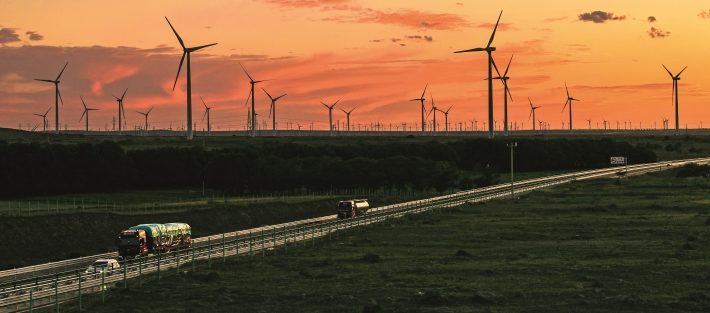COP29 aims to get developed countries to agree to greater financial support for poor climate-vulnerable nations
 The 29th Conference of the Parties to the UN Framework Convention on Climate Change (COP29) is to be held from 11 to 22 November in Baku, Azerbaijan. The main goal of the conference is for countries to agree on a new climate finance target through which wealthy countries will pay to help poorer and climate-vulnerable nations to cope with climate change. On this occasion, ChinAfrica talked to Chukwumerije Okereke, director of the Centre for Climate Change and Development at the Alex-Ekwueme Federal University Ndufu-Alike in Nigeria and also a partner of Allied for Climate Transformation by 2025 (ACT2025), to seek his views on Africa’s and China’s efforts on combating climate change.
The 29th Conference of the Parties to the UN Framework Convention on Climate Change (COP29) is to be held from 11 to 22 November in Baku, Azerbaijan. The main goal of the conference is for countries to agree on a new climate finance target through which wealthy countries will pay to help poorer and climate-vulnerable nations to cope with climate change. On this occasion, ChinAfrica talked to Chukwumerije Okereke, director of the Centre for Climate Change and Development at the Alex-Ekwueme Federal University Ndufu-Alike in Nigeria and also a partner of Allied for Climate Transformation by 2025 (ACT2025), to seek his views on Africa’s and China’s efforts on combating climate change.
ChinAfrica: How do you view the achievements of COP28? What are the highlights of COP28?
Chukwumerije Okereke: COP28 in 2023 resulted in some productive outcomes, including a truth-telling Global Stocktake (GST) – a report card assessing global climate action and support. The GST unveils a stark reality: Progress lags significantly behind the goals of the Paris Agreement, and time is slipping away. To this end, the GST makes it clear that the world must transition away from fossil fuels, and puts in place new global goals to complement the transition, including tripling renewable energy, doubling energy efficiency, and halting deforestation.
However, a GST outcome that merely recognises challenges without support to address those challenges hardly offers much hope. Studies estimate that developing countries will need trillions of US dollars of public and private funding for climate action by 2030. Climate-vulnerable nations are also disappointed by the insufficient response to climate-related disasters. They have stressed that more progress is urgently needed to align with the Paris Agreement’s 1.5-degree-Celsius target.
What is your comment on China’s efforts on combating climate change?
China has already taken notable steps to green its overseas investments and contribute to global climate efforts. China is the world’s largest solar generator. Looking ahead, China can enhance ambition and lead by aligning its actions with the demands of climate-vulnerable nations. This includes supporting adaptation through knowledge sharing, and accelerating its own just transition towards carbon neutrality.
Expectations are high for all G7 and G20 countries; they must send a loud and clear signal for reducing emissions this year to solidify 2025 as the year of increased ambition. In practice, this means that G7 and G20 countries must strengthen their national climate plans (known as Nationally Determined Contributions or NDCs) consistent with 1.5-degree-Celsius pathways and in line with GST learnings. These NDCs, expected well in advance of COP30 in 2025, should indicate economy-wide absolute emissions reduction targets, covering all sectors.
What is your comment on China-Africa partnership on the fight against climate change?
China is an important trading partner of Africa and one of its biggest sources of foreign aid and investment. China is also home to more than 80 percent of the world’s renewable energy manufacturing. All these make China uniquely well positioned to support clean energy expansion and access in Sub-Saharan Africa.
The outcomes of the recently held Beijing Summit of the Forum on China-Africa Cooperation reflect the importance of China-Africa cooperation in shaping a sustainable and equitable climate future. We also see indicators here of China taking steps to green its overseas investments and advance climate action and justice for other parts of the world.
What are the challenges and opportunities faced by China and African countries in combating climate change?
China and Africa need to ensure China’s clean energy investment is directed where it can have the most positive impact. Considering that distributed renewable energy is primarily needed in rural areas of Sub-Saharan Africa, this presents various challenges of access and scale. As such, it is important that local contexts, including terrain and cultural dynamics, dictate how to successfully design and execute projects.
More generally, it can be said that both China and Africa are attempting to strike a balance between climate action, energy security, and long-term economic competitiveness. Both require risk analysis, scenario planning, and common sense based on observable trends.
What role China could play in uniting developing countries to jointly combat climate change?
Given that China’s leadership is crucial to achieving global climate goals, China is well primed to serve as a catalyst for global unity. China has a unique role to play in fostering unity and driving global progress towards a sustainable and equitable future through its support for climate-vulnerable nations. By fostering cooperation among the Global South, China can enhance its support for inclusive and people-centred development that drives global climate action towards a clean and beautiful world.
Indeed, China has consistently been a strong voice for climate justice, particularly through its pivotal role in supporting the G77 to call for the establishment of a loss and damage fund at COP27.
What are your expectations for this year’s COP29?
As we look ahead to COP29, the ACT2025 consortium has outlined four key priorities in our Call to Action, which are critical to building a more inclusive and sustainable future for all. These priorities speak to the financial and climate justice needs of vulnerable nations:
Ambitious climate finance is non-negotiable: COP29 must deliver the New Collective Qualified Goal (NCQG) on climate finance that aligns with the Paris Agreement’s 1.5-degree-Celsius target and reflects the real financial needs of vulnerable nations. The NCQG must cover mitigation, adaptation, and loss and damage.
Scaling up adaptation efforts: COP28’s outcomes fell short of addressing the urgency of the adaptation crisis. COP29 presents a critical opportunity to fill these gaps, not only ensuring that adaptation plans and their implementation are robust, inclusive, and effective, but also that there are sufficient resources available to do so.
Responding to loss and damage with sufficient action and support: The new Fund for Responding to Loss and Damage must be sufficiently funded and fully operational by COP29. The new fund is meaningless if it does not result in accessible finance at scale to meet the immediate needs of vulnerable developing countries and communities in responding to loss and damage, without imposing further burdens such as debt.
Accelerating mitigation ambition and implementation: With 2025 rapidly approaching, countries need clear, people-centred pathways to phase out fossil fuels and a just transition to net-zero greenhouse gas emissions.






